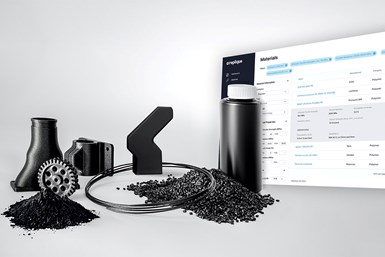Replique Announces Public Launch of 3D Printing Material Hub
Following a successful beta release, the Material Hub is now openly accessible to the broader additive manufacturing community. It contains a collection of more than 400 polymer materials which have been compiled in collaboration with more than 25 material providers.
Share
Read Next
The Material Hub enables users to quickly find the right material according to their requirements. Source: Replique
Replique, provider of a decentralized 3D printing platform for the secure and reliable production of industrial-grade parts, has launched an extensive public Material Hub for 3D printing which is now open to the public following beta testing. After the successful beta release, which the company says received overwhelmingly positive feedback, Replique is now introducing the database to the broader additive manufacturing (AM) community.
The Material Hub is now openly accessible and contains a collection of more than 400 polymer materials, compiled in collaboration with more than 25 material providers. This marks a substantial increase, more than doubling the number of available materials since its initial introduction in November 2023.
Already in the beta phase, the hub helped numerous companies, institutions and partners to access and filter options for the right 3D printing materials in seconds.
“Replique’s Material Hub significantly accelerates the material selection process,” says Mathilde Lepilliez, Alstom innovation manager and 3D printing engineer. “Just recently, we have searched for a material that fulfills our high flame-retardancy requirements as part of a new 3D printing project. Thanks to Replique’s support we were able to find the right material fast and efficiently. This Material Hub will become a part of our daily-basis tools to help us to develop 3D printing.”
Replique says the Material Hub offers a variety of benefits and features to engineers, purchasers and R&D. Users can easily navigate the hub because of the technical filtering options to find the ideal materials for their specific applications, saving time and costs associated with manual research. Detailed technical specifications, industry standards and application fields are provided for each material, ensuring informed decision-making.
Additionally, printer manufacturers, service providers and other stakeholders can benefit from the collective knowledge within the database, fostering collaboration and innovation within the 3D printing community.
With the public launch, Replique has incorporated performance improvements based on user feedback, including an optimized search function. This enables users to either search on a detailed level, such as direction-dependent mechanical properties or on a more beginner-friendly level. Thus, also enabling less-experienced users to use the tool efficiently and get a head start on their adoption of AM. Once a suitable material is identified, users can also directly request a quote to get their parts produced through Replique or reach out to the material provider to clarify further details.
“We are thrilled with the positive reception of our Material Hub during the beta phase,” says Dr. Max Siebert, Replique co-founder and CEO. “The public launch marks an important step in our mission to democratize access to additive manufacturing. We are committed to continuously enhancing the platform to meet the evolving needs of our users.”
In the future, Replique plans on expanding the hub’s capabilities by adding more features and materials. While the current focus is on polymers, adding metal materials is already planned. Material providers interested in showcasing their materials are encouraged to reach out to Replique directly.
Related Content
3D Printed Spine Implants Made From PEEK Now in Production
Medical device manufacturer Curiteva is producing two families of spinal implants using a proprietary process for 3D printing porous polyether ether ketone (PEEK).
Read MoreUnderstanding PEKK and PEEK for 3D Printing: The Cool Parts Show Bonus
Both materials offer properties desirable for medical implants, among other applications. In this bonus episode, hear more from Oxford Performance Materials and Curiteva about how these companies are applying PEKK and PEEK, respectively.
Read MoreActivArmor Casts and Splints Are Shifting to Point-of-Care 3D Printing
ActivArmor offers individualized, 3D printed casts and splints for various diagnoses. The company is in the process of shifting to point-of-care printing and aims to promote positive healing outcomes and improved hygienics with customized support devices.
Read More6 Trends in Additive Manufacturing Technology at IMTS 2024
3D printers are getting bigger, faster and smarter. But don’t overlook the other equipment that the AM workflow requires, nor the value of finding the right supplier.
Read MoreRead Next
Bike Manufacturer Uses Additive Manufacturing to Create Lighter, More Complex, Customized Parts
Titanium bike frame manufacturer Hanglun Technology mixes precision casting with 3D printing to create bikes that offer increased speed and reduced turbulence during long-distance rides, offering a smoother, faster and more efficient cycling experience.
Read MoreAlquist 3D Looks Toward a Carbon-Sequestering Future with 3D Printed Infrastructure
The Colorado startup aims to reduce the carbon footprint of new buildings, homes and city infrastructure with robotic 3D printing and a specialized geopolymer material.
Read MoreCrushable Lattices: The Lightweight Structures That Will Protect an Interplanetary Payload
NASA uses laser powder bed fusion plus chemical etching to create the lattice forms engineered to keep Mars rocks safe during a crash landing on Earth.
Read More






















